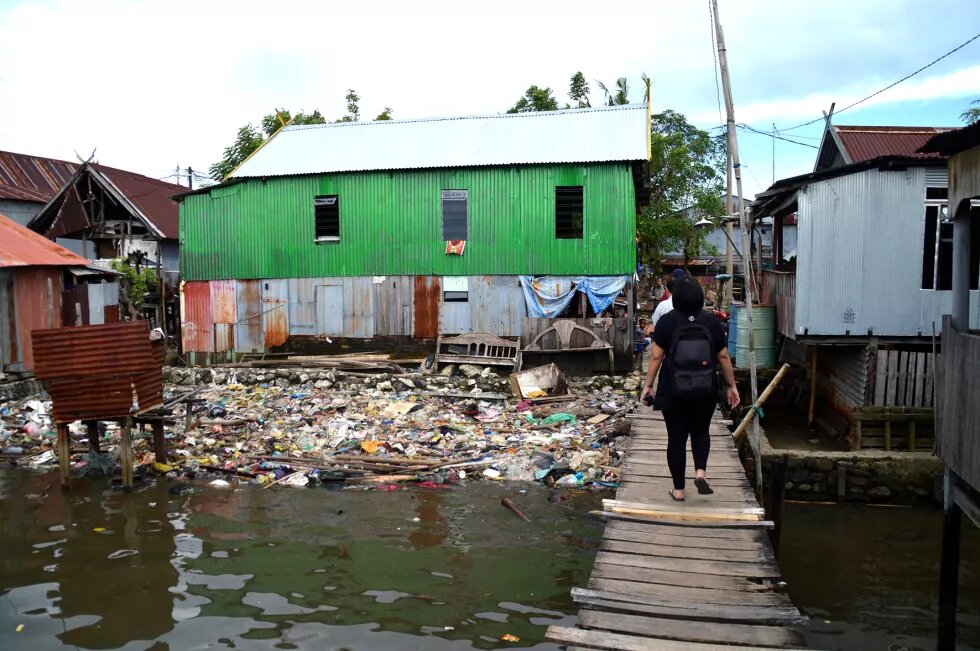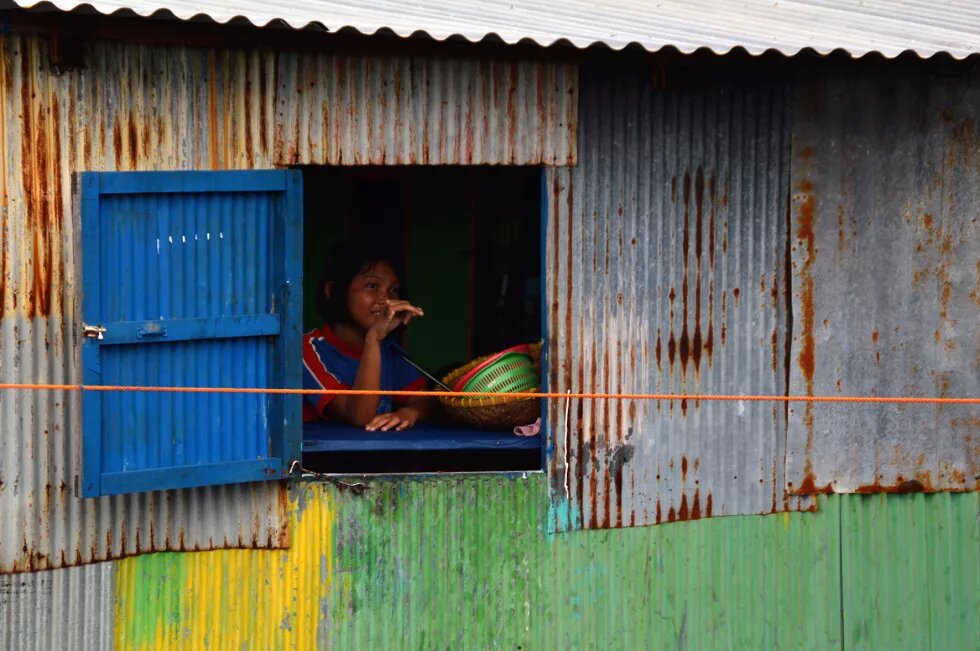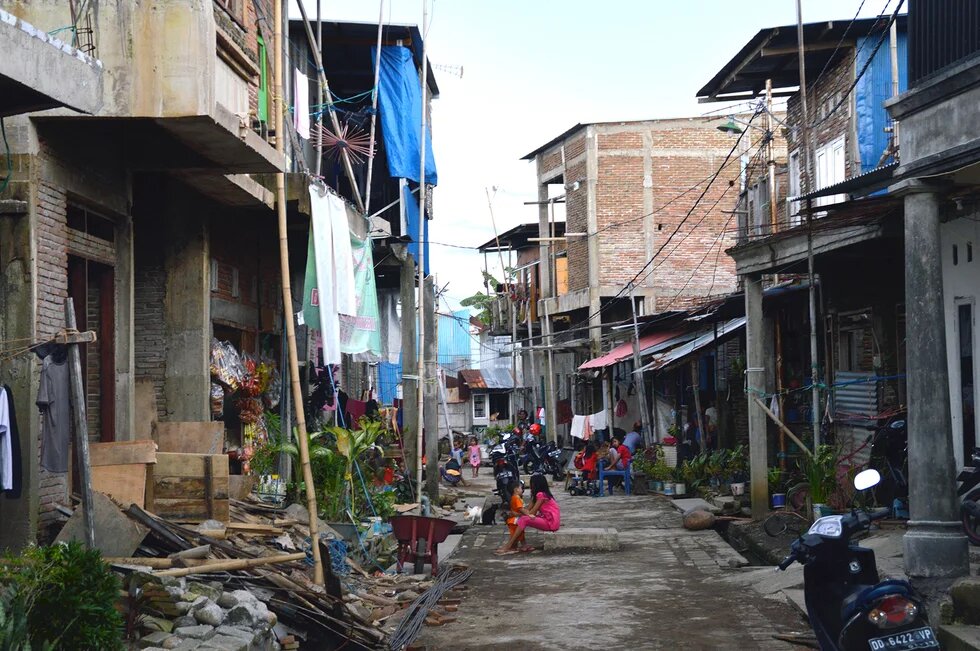

A study of the Indonesian National Slum Upgrading Project
Part I of this article introduced the Indonesian National Slum Upgrading Project (NSUP), a co-financing arrangement between the Government of Indonesia, World Bank and the Asian Infrastructure Investment Bank (AIIB). The community-driven development (CCD) program forms an integral part of the national poverty alleviation strategy KOTAKU (“Cities Without Slums”).
In the following some key issues with the project are raised: 1) How does integrating NSUP into wider city planning affect community input?; 2) How sustainable is the communities’ role in implementation, maintenance, and monitoring?; and 3) Are risk assessment and safeguard implementation sufficient to avoid forced evictions? (All of these questions can only touched on here and were answered in more detail in the full report)
As NSUP is currently in the process of being rolled out across the country, it remains to be seen whether the issues brought up in the analysis will ultimately materialise. To the extent that the past is a meaningful guide to the future, there are however reasons to believe that certain problems in one way or another will prevail. Important aspects of the analysis are based on two comprehensive studies of NSUP’s predecessors, Urban Poverty Program I, II, III [Program Nasional Pemberdayaan Masyarakat] (PNPM), commissioned by World Bank itself (RAND 2011; Schuler and Dwiyani 2012; summarised in: Hermissari et al. 2013). Site visits to Makassar and Banjarmasin complement the analysis.
Moreover, due to its vast scope, complex design and early stage, NSUP withstands a full-scale analysis. It should therefore be noted that the issues brought up here, resemble more of a worst case scenario in order to shed light on necessary improvements. The vast majority of interventions are, in fact, likely to be unproblematic as they concern small-scale infrastructure improvements that, to varying degrees, are the result of a participatory planning process.
Integrated vs. participatory planning: Will local government leadership diminish community input?
A key change from PNPM to NSUP is the much larger role foreseen for local governments. PNPM had been largely designed to be separate of local governments, especially in budgetary terms. The goal was to avoid politicisation and corruption that was sprawling in the early phases of democratisation when the Asian Financial Crisis made more determined action to alleviate poverty necessary. A result was often a lack of political commitment to PNPM.
The new design integrates Community Settlement Plans (CSPs) developed by community organisations (BKMs) at the sub-district level into city-wide Slum Improvement Action Plans (SIAPs) under the auspices of the mayor’s office. This puts local governments in a position where they have to exert extensive coordination of the vast number of social, economic and poverty programs in place. Governance capacity at the local level to successfully handle this task varies considerably, however, as World Banks admits.
More independence in planning for local governments is particularly important for budgeting where they are envisioned to leverage financial resources from various sources and programs in order to fulfil their financial commitments to NSUP. Funding from World Bank and PUPR at the central level requires a review of SIAPs as part of their monitoring. While this is reasonable in terms of monitoring, the procedure is prone to delays. Already under PNPM these delays tended to leave BKMs with little time for implementation, interviews in Makassar and Banjarmasin confirmed.
With a greater role for local governments, issues with lacking inter-ministerial coordination are likely to be more pronounced under NSUP than they were under PNPM. Already in the run-up of the project the two main line ministries responsible for executing NSUP, the National Development Planning Body (BAPPENAS) and the Ministry of Public Works and Housing (PUPR), were confronted with the problem of incompatible data standards for recording slum conditions.
As a result, the process of developing a baseline is still on-going in the cities visited. This is despite the fact that they were chosen as priority sites, following their comparatively strong performance under PNPM. Coordination problems during the planning stages are likely to spill-over to later stages of the project and impede smooth implementation and effective monitoring. Again, cities with lower governance capacities will face particular obstacles in this regard. At the very least, it will put the tight project schedule in question.
Similarly, issues of central-local accountability are likely to resurface. As to how far the largely new oversight structures at provincial will be able to offset the related risks, remains to be seen. World Bank’s own monitoring process appears to only set in once CSPs and SIAPs were developed at the local level and thereby way too late.
Another example from the sub-district of Tallo, Makassar, exemplifies how city agendas may clash with the interest of communities. In Tallo, already under PNPM plans for resettlement were developed because people “illegally” built stilted housing along the coast line. For now, the community was able to fend of resettlement to vertical housing which would have come with excessive rent-payments. In the longer run, however, the stilted houses are in the way of the mayor’s plans for large-scale land reclamation to upgrade the harbour, energy production facilities, and develop land for business and residential areas. Moving inland instead was considered less alluring at BAPPEDA.
Arguably the strongest built-in safeguard in NSUP is the fact that communities elect their own BKMs to develop CSPs. However, realising meaningful community participation and buy-in is a time-consuming task, especially with regard to women and the poor (Azarbaijani-Moghaddam 2015; RAND 2011, 38; Schuler and Dwiyani 2012, 5). In a survey less than 20% of community members even knew their BKM.
One reason for this was the fact that facilitators tended to be overworked and only had little time to spend with communities. The budget increase under Program Component 2 that results in a much higher number as well as a 30% female quota for facilitators are thus steps in the right direction. Whether they will be enough, is can be doubted though.
ARKOM Makassar, a local NGO that had successfully negotiated a land sharing agreement and resettlement of an illegal settlement to an adjacent piece of land, confirmed how arduous the process of community planning is. Confronted with considerable animosity in the early stages, moving on with the project required a personal commitment that can hardly be taken as a given. In contrast to NSUP, ARKOM also puts community planning completely in the hands of women as a way to improve community buy-in.
Several of the problems discussed above potentially come together in many of the illegal settlements that were newly added under NSUP. Not only do these settlements have no BKM place, they are also likely to be the ones where the most problematic interventions are necessary. Facilitators do not seem to be trained to handle more difficult interventions. The City Coordinator and Head of the NSUP’s Supporting Line in Makassar confirmed that facilitators sometimes need to be replaced because they stir rather than solve conflicts.
To date, it is unclear how many sub-districts will be affected by similar problems. While many sub-districts were already targeted under PNPM, a sizeable portion was not. In Makassar, 10 out 153 sub-districts had no BKM in place yet. This share will probably be higher in lower-performing cities that will be targeted later on in the project cycle.
Implementation, maintenance, and monitoring: How sustainable is informal taxation of communities?
A lack of community participation also creates negative spill-over effects for later project stages such as implementation and maintenance. Interestingly, much of the implementation work at the community level is done by voluntary implementation groups (KSMs), financially supported by rolling funding. Since the days of independence Indonesia has developed a communitarian ideology of mutual assistance (gotong royong) that by now is deeply engrained in community structures all over the country.
Community organisers such as ARKOM positively refer to the concept as an important building block for community self-empowerment. There is, however, a thin line between empowerment and semi-obligatory unpaid work. Especially where imposed externally, it rather resembles a form of “informal taxation” (Olken and Singhal 2011).
Moreover, relying on voluntary community work for implementation and maintenance is problematic where there has been a lack of community participation in the actual planning process. This seems to have been a common pattern under PNPM (Chayati, Sarwono, and Mardiyono 2014).
One aspect here is the lack of familiarity and ultimately (technical) understanding of planned interventions.
Another is a potentially higher mismatch with community needs. Without sense of ownership community maintenance is not an effective substitute for poor government-driven maintenance. World Bank seems to recognise the need for better maintenance and requires SIAPs to include maintenance budgets.
Lower community participation also diminishes project monitoring. Unfortunately, the program documentation includes less stringent requirements for involving communities than it possibly should. The only mandatory requirement is to make project information publicly available. All other measures are marked as desirable (“should”) such as making project activities and budgets public, holding open meetings in which communities are allowed to participate, monitoring and holding authorities accountable, and providing technical assistance and capacity building to the communities (World Bank 2016, 66). To a large degree this role is passed on to facilitators instead.
Risk assessment and safeguard implementation: What is the risk of forced evictions?
The diminished role of community monitoring makes an effective implementation of World Bank’s ESMF only more important in order to avoid negative impacts on affected communities. Unfortunately, there are several factors that put this into question.
One factor is World Bank’s risk assessment. With most interventions being confined to in-situ upgrading of infrastructure at the community level the “potential environmental and social impacts...will be low to moderate,” World Bank argues (World Bank 2016, 8). It expects that the nature of interventions will make involuntary resettlement exceptional. Instead, voluntary land donation is expected to be the prevailing scheme as this has already been the case under PNPM (Ministry of Public Works and Housing 2016, 20).
Although this may be the case for most upgrades of tertiary infrastructure at the community level, it does not necessarily apply to city-wide infrastructure development. Still, based on this assumption, World Bank downgraded the risk assessment from Category A (“substantial”) to Category B (“moderate”) in early 2016 which lowers requirements for due diligence.
The decision is highly questionable because the bank’s risk assessment is preliminary at best. Only at the end of the planning process, which for some sub-districts means by 2018/19, the actual need for resettlement will have been identified as part of the CSPs, DEDs, and SIAPs. Somewhat strangely framed as a point in favour of the official line of argumentation, World Bank even admits that the short time-frame of the project will not allow for the development of resettlement plans (World Bank 2016, 22).
A consortium of environmental, social and human rights NGOs fears that the downgrade was made possible by shifting more problematic sub-districts out of the NSUP portfolio into fully government-funded projects. The concern is not unfounded. According to someone with intimate knowledge of the process, PUPR at the highest level now insists that NSUP will not target illegal settlements, a claim that completely contradicts prior statements and the program documentation.
PUPR’s rationale is founded in the requirement that local governments must develop Land Acquisition and Resettlement Action Plans (LARAPs) at their own cost as part of World Bank’s Land Acquisition and Resettlement Policy Framework (LARPF). The framework applies because the domestic legal framework is inadequate in terms of rules for public disclosure, consultation, compensation (in particular of slum-dwellers without formal land rights), special rights of vulnerable groups, livelihood restoration, budgeting for resettlement cost, and the grievance redressal mechanism.
Even then things are far from safe. Although developing a LARAP is indeed mandatory, it appears that most individual provisions are not. According to the official documents, “PAPs [Program Affected People] should be meaningfully consulted... and should have opportunities to participate in planning and implementing the land acquisition and resettlement programs...[L]iving conditions should not be worse-off” (Italics by author) (Ministry of Public Works and Housing 2016, 30).
Whether non-mandatory provisions that appeal to local governments’ goodwill will be sufficient to avoid evictions remains doubtful. At least at PUPR Makassar, safeguards were merely considered a “trend,” possibly because they see the many other problems that plague NSUP. If this is the attitude with which land right and land tenure policy reform under Program Component 1 is pursued, chances are slim that such reform will happen. In fact, it should have been a mandatory requirement before NSUP started in the first place.
Some policy recommendations for a safer NSUP
It seems that World Bank has identified many of the right issues with NSUP. Most of its capacity building measures target real problems that plagued infrastructure development in the past. Its safeguard handling, however, seems negligent to say the least, given that the bank is well aware of the flaws in Indonesia’s legal framework.
To avoid negative impacts on the people affected by NSUP several steps should be taken. A more realistic time-frame would reduce the pressure on local governments to fulfil the overly ambitious 100-0-100 target. It would also increase the time to realise meaningful community buy-in. This would smoothen implementation, increase sustainability, and strengthen monitoring. Furthermore, it would provide more time for policy reform of the flawed legal framework and the development of resettlement plans under the aegis of World Bank. As none of this is likely to happen, it will be on civil society to play the watchdog.
References
Azarbaijani-Moghaddam, Sippi. 2015. “Gender Inclusion Strategies in PNPM.” Jakarta: World Bank.
Chayati, Noor, Sarwono Sarwono, and Mardiyono Mardiyono. 2014. “The Implementation of Community Empowerment Program in Reducing the Poverty (Case Study of PNPM-Mandiri Urban in Besito Village, Gebog Sub-District, Kudus Regency, Central Java Province, Indonesia).” WACANA, Jurnal Sosial Dan Humaniora 16 (3): 125–31.
Hermissari, Evi, Jan Weetjens, Bondan Sikoki, Peter Glick, Joanne Yoong, Francisco Perez-Arce, Nicholas Burger, et al. 2013. “Indonesia - Evaluation of the Urban Community Driven Development Program : Program Nasional Pemberdayaan Masyarakat Mandiri Perkotaan (PNPM-Urban).” 79903. Jakarta: World Bank.
Ministry of Public Works and Housing. 2016. “The National Slum Upgradin Program. Environmental and Social Management Framework.” Jakarta.
Olken, Benjamin A., and Monica Singhal. 2011. “Informal Taxation.” American Economic Journal: Applied Economics 3 (4): 1–28.
RAND. 2011. “Process Evaluation of the PNPM Urban.” Santa Monica: RAND.
Schuler, Nina, and Risye Dwiyani. 2012. “Rapid Appraisal of PNPM Neighborhood Development (and Poverty Alleviation Partnership Grant Mechanism).” Jakarta: World Bank.
World Bank. 2016. “National Slum Upgrading Project: Project Appraisal.” Washington D.C.: World Bank.

